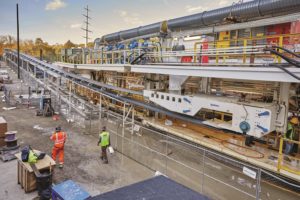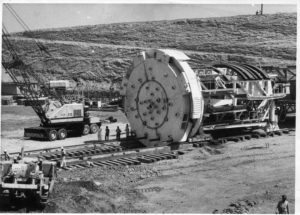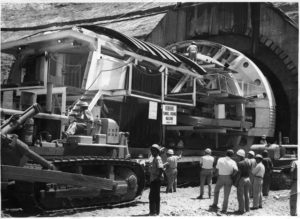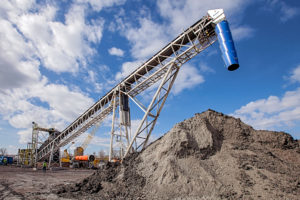Author: Keri Lin
罗宾斯敞开式吉林断层再创中国隧道掘进新纪录
In mid-May 2018 the national-record-setting 7.9 m (26 ft) Robbins Main Beam TBM at the Jilin Lot 3 Tunnel broke through. A formal ceremony followed to commemorate the stellar performance of the tunneling operation and its early completion. “I have participated in this project from the beginning. The project broke through 147 days earlier than scheduled. The project has achieved the fastest monthly advance rate record–1423.5 m/4,670 ft—for 7 to 8 m (23 to 26 ft) diameter TBMs in China. And the machine has reached over 1000 m (3,280 ft) per month for three consecutive months. I am so proud of these achievements,” said Mr. Wu Zhi Yong, Vice Chief Engineer and Jilin Yinsong Project Vice General Manager for contractor Beijing Vibroflotation Engineering Co. Ltd. (BVEC).
2018年5月中旬,吉林第三标段隧道的直径7.9 m罗宾斯主梁式掘进机创下新纪录。工地举行了一个仪式以庆祝隧道施工的出色表现及提前竣工。“我从一开始就参与了这个项目。这项工程比计划提前147天竣工。该项目以1423.5米/月的速度刷新了中国7至8米直径的掘进机的最高月掘进纪录。机器已经连续三个月达到每月1,000米以上。我为这些成就感到骄傲。”承包商北京振冲公司(BVEC)副总工程师、吉林引松项目副总经理吴志勇先生说道。
The completion of the 24.3 km (15 mi) tunnel nearly five months ahead of schedule is a monumental achievement considering the difficult ground conditions encountered. Rock types ranged from tuff to granite, sandstone, and andesite with multiple fault zones—conditions requiring nearly continuous ground support. Rock strengths varied widely from 35 to 206 MPa UCS (5,100 to 30,000 psi). The contractor cited a number of factors that contributed to the swift advance rates: “It is the stable and reliable performance of the Robbins machine, and the professional technical skills of the service technicians. The Robbins crew coordination, reasonable working progress arrangements and the sophisticated technology all allowed the project to make the fast advance rate,” said Mr. Wu.
The Robbins Main Beam TBM bored through a total of 24 fault zones utilizing a unique combination of steel McNally slats (extruded through pockets in the TBM roof shield to prevent movement of loose rock), wire mesh, and shotcrete. The TBM was specifically designed to tackle the tough conditions. “Under the variable ground conditions, especially weak, soft, and fractured rock, the optimized system and reasonable design of the machine ensured effective tunneling progress. Robbins’ unique gripper system, continuous propel system, hydraulic drives, roof support and stable cutterhead reduced the wear of cutters.The efficient belt conveyor inside the main beam allowed quick muck removal from the cutterhead to the back of the machine, which ensured the good progress of the TBM,” said Mr. Wu.
The Jilin Lot 3 tunnel is part of the Jilin Yinsong Water Supply Project, which at 736.3 km (457.5 mi) is China’s largest scale water diversion project to date. Once operational the water lines will divert the water from Fengman Reservoir at the upper reaches of Di’er Songhua River to central regions of Jilin Province experiencing chronic water shortages. These regions include the cities of Changchun and Siping, eight surrounding counties, and 26 villages and towns under their jurisdiction. The project will optimize water resource distribution, improve regional eco-systems, and ensure better food production and water safety for the people of Jilin Province.
第一台掘进机的输送机
Modern Achievements

The 100th conveyor system has been refurbished and customized for the job in a process that Robbins has been perfecting for decades.
There are many elements that contribute to the success of a project: having an accurate report of ground conditions, choosing the proper equipment, having a well-trained team operating the tunnel boring machine—and behind it all—the utilization of a high-quality conveyor system. As tunneling machines evolve and bore at continuously faster rates, rapid muck removal becomes more important than ever. Robbins conveyor systems are capable of moving more than two thousand US tons of muck per hour—saving time and money on every project that uses the complete system.
In Akron, Ohio, a major milestone has been reached for Robbins conveyors. Running behind a Robbins 9.26 m (30.4 ft) diameter Crossover TBM is the 100th Robbins Continuous Conveyor System supplied for muck removal—more than any other TBM conveyor supplier has sold. The conveyor in Akron is just one landmark event in the long history of Robbins conveyors, the start of which can be traced back to the first ever documented use of a continuous conveyor system behind a TBM.
Pioneering Muck Removal

No roads were at the site in West Pakistan so goods were transported by rail car, requiring surveying of hundreds of bridges from the port city of Karachi.
The prototype for the conveyor systems we know today was developed by James S. Robbins in 1963 and was built using a Goodman coal-mine conveyor instead of muck cars which were more commonly used during that period. The conveyor ran behind what was, at the time, the largest TBM in the world. The 11.2 m (36.7 ft) diameter Robbins Main Beam was built for the Mangla Dam Project in what was then known as West Pakistan. The 4.3 km (2.7 mi) long tunnel was built to control water flow from the Jhelum River for use in agriculture and hydro-electric power.

Temperatures at the jobsite climbed up to 53 degrees C (127 degrees F) in the shade.
The conveyor design had originally been used for coal and potash mines and was adapted for use behind the TBM. An extendable belt was side-mounted in the tunnel, leaving room for man-access and rail tracks to carry materials. Belt tension was maintained using a belt cassette. “They were able to operate continuously. It worked like a charm—and then the extensible conveyor was forgotten by the industry because it was perceived by contractors and owners as too much of an investment,” explained Dick Robbins, former President and CEO of The Robbins Company, in a 2013 article for World Tunnelling. It would be another 30 years after the successful completion of the Mangla Dam tunnel until conveyors became a standard means of muck removal in the tunneling industry.
Persistently Moving Forward
Conveyors have come a long way since their first use. Unlike the system used for the Mangla Dam project—which was limited to the use of a straight belt—conveyors can now wrap around curves and bring rock vertically up a shaft to the surface. “The control system, along with monitoring systems, has dramatically improved,” says Dean Workman, Robbins Director of Conveyors, Cutters, and SBUs. “The components have all been enhanced, giving a much longer life to the conveyor system. Contractors are using the same conveyors on multiple projects with minor refurbishments between projects.” While the basic function of a conveyor has stayed the same—muck hauling—the quality of conveyor systems has certainly changed.

Did You Know: At least 75% of all world records achieved by TBMs were done with a continuous conveyor system for spoils removal rather than muck cars.
In a new design that is being used for the Los Angeles Purple Line Extension, continuous conveyors have gained another ability, they are now able to change direction. The unique system can be flipped to accommodate two machines boring parallel tunnels eastward before being re-launched to bore west. Due to the narrow launch shaft, modular components were designed to save space, and were built using a kit of secondhand parts, showcasing the long-life conveyor systems are capable of. “We are always looking to improve the design and function of the system,” says Workman, “modular components are a benefit to the contractor when installing, maintaining, and shipping the equipment.”
As progress continues and new technology provides advancements for the industry, The Robbins Company continues to uphold the pioneering spirit that James S. Robbins brought to tunneling with his trailblazing developments.
Read More:
Robbins Conveyor Systems
Conveyor Spec Sheet
100th Conveyor

 Close
Close  Menu
Menu 